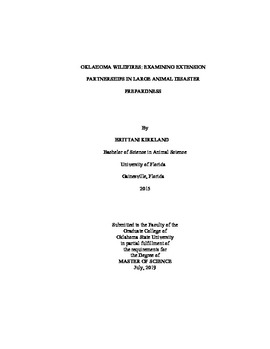| dc.description.abstract | Oklahoma wildfires negatively impact livestock communities throughout the state. To reduce these impacts, two stakeholders have been given responsibility to assist with disaster preparations, Emergency Managers (EMs) and Extension Educators (EXTs). The purpose of this study was to evaluate these stakeholders' roles, needs, training, resources, and partnerships, in regard to livestock related disaster planning for wildfires. Four EMs and four EXTs who worked in rural communities significantly affected by wildfires were interviewed while reflecting on preparedness for previous wildfires. Transcribed interviews were coded, with categories created with Community Capitals Framework. Categories included: natural, built, human, social, financial, political, and cultural capitals. Capital frequency and overall count were evaluated, and themes were recorded. Four individuals identified roles in livestock disaster planning and four reported these roles as formal. Three respondents reported receiving training. Only two reported knowing about available training opportunities, while five reported training needs. Numerous physical and social resources were reported as available for planning and response. Interactions between EMs and EXTs were reported by all respondents (n = 8), with some interactions being limited (n = 2). Only five of these interactions occurred before recent fires. Social and built capital was referenced by 100% of respondents. Human (87.5%), cultural (62.50%), political (37.5%), natural (25%), and financial (12.50%) capitals were also referenced with varying frequencies amongst respondents. Few EMs and EXTs previously planned for livestock related disasters. Therefore, specific roles should be assigned and communicated by the state. Respondents reported training was needed but were unaware of trainings available. As national and state training programs are offered better communication on availability of programs is warranted. Collaborative conversations should be encouraged between EMs and EXTs to allow for greater identification of physical and social resources. Interactions between EMs and EXTs are occurring, but not for livestock disaster planning purposes. Therefore, partnerships should be encouraged to occur for livestock disaster planning specifically. Assessment of the strength, quality, and longevity of these relationships should be evaluated in future studies as well as exploration of capital needs for livestock related disasters. | |
